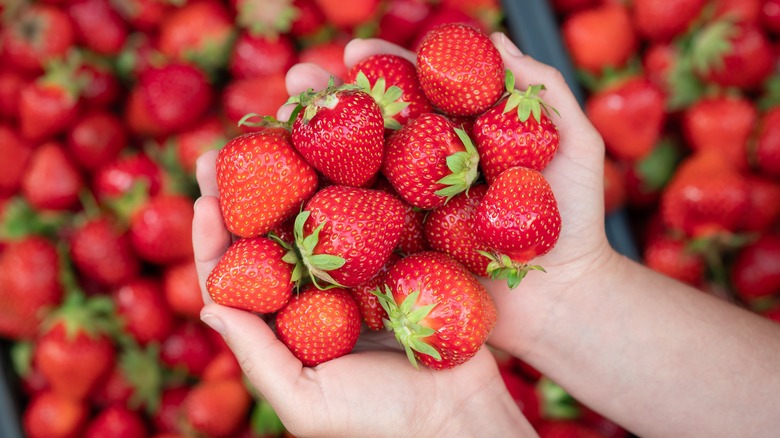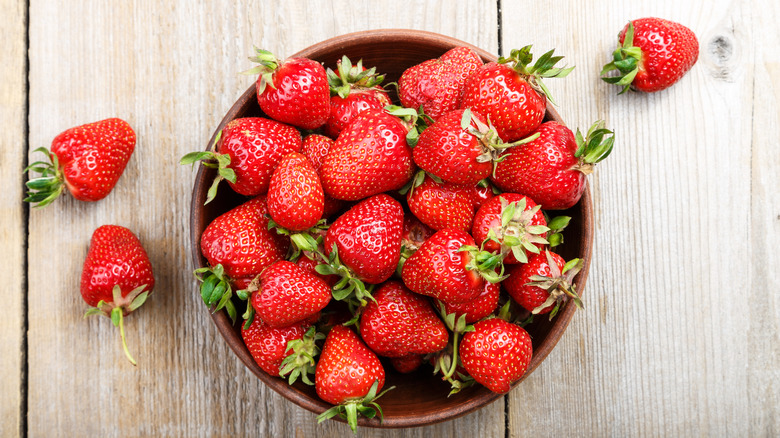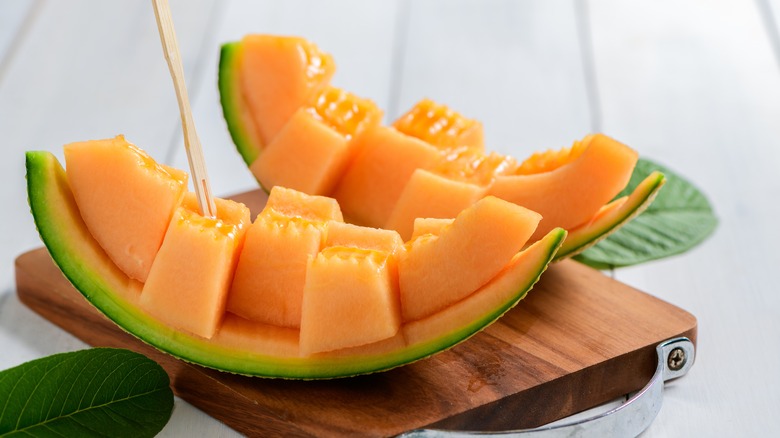Why Bijin-Hime Strawberries Are So Expensive
In most cases, you might expect to pay around $3 for a pound of fresh strawberries — perhaps a bit more depending on the season and where the fruit was grown. What you probably wouldn't expect, however, is to shell out 50,000 yen (roughly $325) for a single red strawberry. But this is no ordinary berry. This is a Bijin-hime. Named after the Japanese word for beautiful princess, it's one of the most expensive varieties of the fruit in the world.
Known for its sweet rose-like fragrance, each Bijin-hime strawberry is roughly the size of a baseball. Moreover, unlike some strawberries that fade into a shade of white in the center, Bijin-hime retains its shiny red hue throughout the fruit. The berry is also renowned for its plump and firm texture that gives way to a soft flesh bursting with syrupy juice. Perhaps of most importance though is the berry's exceptional flavor.
While strawberries are usually laced with a tinge of acidity, Bijin-hime has an unparalleled sweetness to it. For instance, the Brix Scale (the indicator used to measure a fruit's sugar content) come in around 7 for an average strawberry in America. A Bijin-hime, however, has a Brix of 13, giving it a distinct cloying sweetness unlike any other variety. Even Paul Hollywood was giddy after a bite of one on his show "Paul Hollywood Eats Japan," calling it a fruit that's like "an apple meets a strawberry, meets a grape, meets a whole bunch of red roses" in all the best ways (via YouTube).
Bijin-hime strawberries were invented by a Japanese farmer
Even though there are some things that you may not know about strawberries, one big thing to know is that they are an extremely popular fruit in Japan. Over 300 varieties of the berry are grown in the country — each cultivated by farmers in carefully controlled greenhouses to have distinct flavors and colors. Gifu-based Mikio Okuda is one such experienced strawberry farmer who began crossbreeding different types at his greenhouse in Hashima. After 15 years of experimenting and supervising the soil and air temperature, Okuda finally grew the first Bijin-hime that has been consistent in taste, texture, and appearance every single year.
Okuda is the world's sole producer of Bijin-hime berries and has never revealed much about which varieties were crossbred or the process used to grow the fruit. What's known is that Okuda covers his plants with rice straw for better control over the precious berries as they grow, and that he either allows honeybees housed in the same greenhouse to pollinate the plants or does the job himself. The juicy fruits are then left to ripen at a slow pace during winter and, when ready, Okuda looks at the flower petals to distinguish Bijin-hime from other strawberries growing in his farms (whereas regular strawberry flowers have six petals, Bijin-hime will have eight to nine). The fruit is then packed and shipped off to the highest bidders in the world — after all, Okuda only grows 500 of them each year!
Some of the world's most expensive fruits are from Japan
The price tag of Bijin-hime strawberries may come as a revelation to many, but it's hardly the costliest fruit grown or sold in Japan — the country is known to have a penchant for rare and expensive fruits. That's because they are seen as more than just sustenance: they are bought and exchanged as gifts in a centuries-old practice. As such, fruits are a luxury, and emphasis is placed on quality over quantity, perfection of appearance, and superiority of flavor. And fruits like a single, utterly sweet, juicy, and glossy strawberry that costs 50,000 yen fit the bill impeccably.
In 2019, a pair of Yubari King or Yubari melons grown in Japan were sold for 5 million yen (approximately $63,000). In 2023, another pair was auctioned for 3.5 million yen, placing it on top of the list of most expensive fruits in the world. Melons aside, Japan is home to square-shaped watermelons that cost $100 a piece, as well as ping pong ball-sized grapes that fetch up to $450 a bunch, and apples that cost $20 each. In fact, Bijin-hime isn't the only Japanese strawberry that is worth a handsome price: There are also pale pink and white strawberries that cost $100 a box of 10, and amaou — or the "king of Japanese strawberries," as it is dubbed — that fetches $10 for a single berry.



